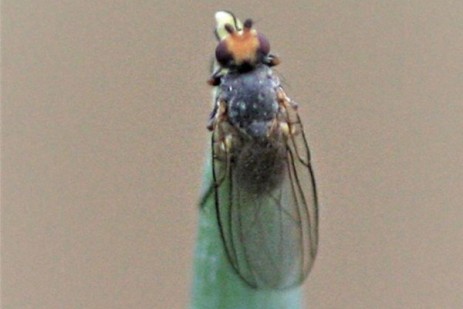This makes two years in a row that the fall allium leafminer (ALM) emergence occurred in this last week of September. ALM attacks plants in the Allium genus including onion, garlic, leek, scallions, shallots, and chives.
The first signs are the linear series of round white dots on allium leaves. The white dots are made by the female with her ovipositor. Both males and females feed on leaf sap, and egg-laying occurs at this same time. You can distinguish the adult fly by the orange patch on the head, and the wings folded horizontally over its back (Figure 1). The flies tend to be found at the tips of the leaves in the morning. A good place to look for signs of ALM is on wild garlic, actively growing scallions and leeks.
ALM has two generations per year. It overwinters as a pupa in leaf tissue or adjacent soil, emerges in the spring, and adult flight occurs over 4-5 weeks. Eggs are laid in allium leaf tissue. Larval development progresses to the pupal stage but is then delayed as the pupa undergoes summer aestivation (a resting period with little to no development), and they do not emerge again until the fall. It is this fall generation that is emerging now.

Figure 2. Egg-laying and feeding scars on a leek leaf. Photo: B. Lingbeek, Penn State
Control measures are only needed during the adult flight to target adults, and very shortly after to target developing larvae. Control can be achieved with row covers during the adult flight, or insecticides. Through the support of PVGA and NIFA, we compiled efficacy trials, detailed in Nault et al. 2020. Foliar applications of Scorpion (dinotefuran), Exirel (cyantraniliprole), and Radiant (spinetoram) were the most effective and consistent.
In some trials, Agri-Mek (abamectin), Assail (acetamiprid), Triguard (cyromazine), Admire (imidacloprid), Warrior (lambda-cyhalothrin), Lannate (methomyl) and Entrust, (spinosad) which is an organic option, were effective. Foliar applications of Aza-Direct (azadirachtin), Surround (kaolin clay), Pyganic (pyrethrin), and Movento (spirotetramat) were not effective. Chemigation treatments also were not effective. Surprisingly, Pyganic plots had higher infestations than control in some trials.
Alliums have a very waxy leaf, so including a spreader sticker or a soap for organic production, is recommended. We used LI-700 for the conventional treatments and M-Pede for the organic treatments. We sprayed weekly, for 4 to 6 weeks, to span the time adults were active, but further work is needed to see if we could reduce the number of applications.

















